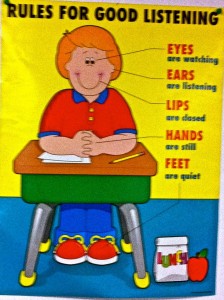Education, Learning Styles and Annoying Posters
The traditional approach to education is summed up best in this “Rules for Good Listening” poster. The message is straightforward: “Good students sit still, they don’t wiggle, they look forward and open up the 2 ears that God gave them, because God gave us two ears and one mouth so we would listen twice as much as we talk!”
I don’t want to refute the theology of this statement (I will save that for a later post) but I do want to point out the damaging nature of this methodology of teaching. This method of teaching assumes that all students learn the same way. The problem is that research proves students have different learning styles and not all students will benefit from these “Rules for Good Listening.” Not only that, but some students may actually be harmed by this method of teaching.
One of the most popular models for learning styles proposes that there are three main types of learners.
- Visual learners :: Visual learners learn through seeing. These students will watch the teacher’s facial expressions and body language. They tend to think in pictures and appreciate diagrams, images, maps and hand-outs. When they are able to represent concepts with images, they can better understand meaning.
- Auditory leaners :: Auditory learners learn through listening. These students are the ones for whom “The Rules for Good Listening” poster was created. They learn best from verbal lectures and written information often has little meaning until it can be heard.
- Kinesthetic learners :: Kinesthetic, or tactile learners, learn through moving, doing and touching. These are the students that are often misunderstood and can even be harmed by the concepts expressed in the “Rules for Good Listening” poster. They don’t learn from sitting still, looking forward and listening. This actually hinders their learning experience. These learners learn best through a hands-on approach as they actively explore the world around them.
The best teachers create lessons that are intentionally geared for all three types of learners. It is much more difficult because it takes more time and mental energy, but it is worth it because the impact is much greater.

